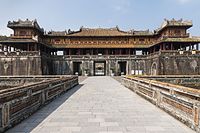Hue, Vietnam
|
Huế Thành Phố Huế |
|
|---|---|
| City | |
| Nickname(s): City of Romantic, Festival City | |
| Location of Huế | |
| Coordinates: 16°28′00″N 107°34′45″E / 16.46667°N 107.57917°E | |
| Country |
|
| Province | Thừa Thiên–Huế |
| Area | |
| • Total | 70.67 km2 (27.29 sq mi) |
| Elevation | 15 m (49 ft) |
| Population (2015) | |
| • Total | 354,124 |
| • Density | 5,010.9/km2 (12,978/sq mi) |
| Climate | Am |
| Website | huecity.gov.vn |
 |
|
| UNESCO World Heritage Site | |
|---|---|
| Location |
Vietnam |
| Criteria | iv |
| Reference | 678 |
| Coordinates | 16°28′N 107°35′E / 16.47°N 107.58°E |
| Inscription | 1993 (17th Session) |
| Website | www |
|
[]
|
|
Huế (Vietnamese: [hwě] is a city in central Vietnam that was the seat of Nguyen Dynasty emperors and the national capital from 1802–1945. A major attraction is its vast, 19th-century Citadel, surrounded by a moat and thick stone walls. It encompasses the Imperial City, with palaces and shrines; the Forbidden Purple City, once the emperor's home; and a replica of the Royal Theater.
Huế originally rose to prominence as the capital of the Nguyễn lords, a feudal dynasty that dominated much of southern Vietnam from the 17th to the 19th century. In 1775 when Trịnh lord Trịnh Sâm captured it, it was known as Phú Xuân.
In 1802, Nguyễn Phúc Ánh (later Emperor Gia Long) succeeded in establishing his control over the whole of Vietnam, thereby making Huế the national capital.
Minh Mạng (r. 1820-40) was the second emperor of the Nguyễn Dynasty, reigning from 14 February 1820 (his 29th birthday) until his death, on 20 January 1841. He was a younger son of Emperor Gia Long, whose eldest son, Crown Prince Cảnh, had died in 1801. Minh was well known for his opposition to French involvement in Vietnam, and for his rigid Confucian orthodoxy.
During the French colonial period, Huế was located in the protectorate of Annam. It remained the seat of the Imperial Palace until 1945, when Emperor Bảo Đại abdicated and a communist DRV government was established with its capital at Hà Nội (Hanoi), in the north.
While Bảo Đại was proclaimed "Head of the State of Vietnam" with the help of the returning French colonialists in 1949 (although not with recognition from the communists or the full acceptance of the Vietnamese people), his new capital was Sài Gòn (Saigon), in the south.
...
Wikipedia


